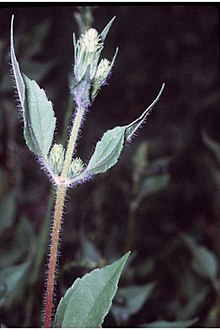Iva annua, the annual marsh elder[3] or sumpweed, is a North American herbaceous annual plant in the family Asteraceae that was historically cultivated by Native Americans for its edible seed.
| Iva annua | |
|---|---|
 | |
| Scientific classification | |
| Kingdom: | Plantae |
| Clade: | Tracheophytes |
| Clade: | Angiosperms |
| Clade: | Eudicots |
| Clade: | Asterids |
| Order: | Asterales |
| Family: | Asteraceae |
| Genus: | Iva |
| Species: | I. annua |
| Binomial name | |
| Iva annua L. 1753 | |
| Synonyms[2] | |
| |
Description
Iva annua is an annual herb up to 150 cm (5 feet) tall. The plant produces many small flower heads in a narrow, elongated, spike-like array, each head with 11–17 disc florets but no ray florets.[4]
Distribution
It is native to northeastern Mexico (Tamaulipas) and to the central and southern United States, primarily the Great Plains and Mississippi Valley as far north as North Dakota. There are some populations in the eastern US, but these appear to represent introductions.[5]
Conservation
NatureServe evaluated Iva annua in 1998 as globally secure, G5.[1]
Uses
Iva annua was cultivated for its edible seed by Native Americans around 4,000 years ago[6] in the central and eastern United States as part of the Eastern Agricultural Complex. It was especially important to the indigenous peoples of the Kansas City Hopewell culture in present-day Missouri and Illinois. The edible parts contain 32 percent protein and 45 percent oil.
However, like its relative ragweed, sumpweed possesses many objectionable qualities which include being a severe potential allergen and possessing a disagreeable odor. Probably for these reasons it was abandoned after more pleasant alternatives (such as maize) were available and, by the time Europeans arrived in the Americas, had long disappeared as a crop.[7]
See also
References
External links
 Media related to Iva annua at Wikimedia Commons
Media related to Iva annua at Wikimedia Commons Data related to Iva annua at Wikispecies
Data related to Iva annua at Wikispecies- Plants Profile for Iva annua (annual marsh elder)
- Germplasm Resources Information Network−GRIN: treatment of Iva annua
- "Iva annua L." MissouriPlants.com. Retrieved August 23, 2022. Includes photographs.
- Photo of herbarium specimen at Missouri Botanical Garden


